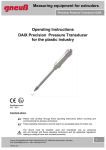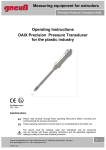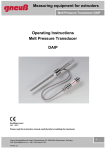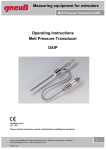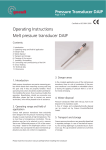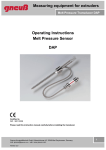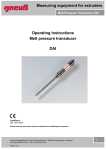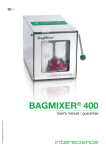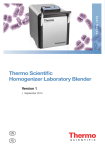Download Operating Instructions Pressure Transducer Testing Unit
Transcript
Operating Instructions Pressure Transducer Testing Unit Version 3 Melt pressure transducers are often operated under very rough production conditions. This may lead to the transducer being mechanically damaged, however, this does not necessarily lead to the measuring accuracy being impaired. The correct function of the transducers can be tested with the pressure transducer testing unit. Scope of supply: 1. Suitcase with foamed intermediate layer. 2. Hydraulic pressure transducer testing unit with digital pressure gauge (high-precision measurement of 0-1000 bar) with turnstile. 3. 2 indicator plugs G 1/2-a. 4. 2 adaptors G 1/2-a to 1/2"-20 UNF and 2 adaptors G 1/2-a to 18 x 1,5. 5. 1 roll of caulking strip. 6. 1 screw driver for levelling the digital pressure gauge. 7. Acceptance Certificate 3.1B Technical Data: Pump Pressure gauge Pressure 1st cylinder : 250 bar Maximum pressure : 1300 bar Filling medium : Univis J13 Generation of pressure : turnstile reversible Fine setting : lateral hand wheel Connections : 3 x G1/2-a 2 x adaptors 1/2" 20-UNF and M18x1,5 Dimensions LxWxH : 290x190x110 mm Weight : approx. 8 kg Measuring range Pressure 2nd cylinder Overload safety Overload display Display : 0 - 1000 bar : 1000 bar : Double nominal pressure : flashing LCD-display : 3 1/2 figure LCD-display with negative sign Measuring rate : 3 measurements per second Characteristic variation : < +/- 0,25 % from final val. Hysteresis : < +/- 0,02 % from final val. Reproductibility : < +/- 0,04 % from final val. Environmental temp. : 0 - +40 °C Compensated range : 0 - +40 °C Storage temperature : -15 - +50 °C Pressure connection : G 1/2 a at the bottom Supply voltage : 9 V block battery with automatic cut-off after approx. 20 min. Battery state display : Low Batt signal on LCDdisplay Zero-point setting : via potentiometer on the housing Maintenance : no special maintenance necessary Seite 1 - Bedienungsanleitung Druckaufnehmerprüfgerät, Version 3-e 18.08.2000 Tel Operation: Hand wheel for fine setting Caulking strip Pressure transducer Blanking plug Adaptor for transducer Blanking plug Display pressure gauge Low-pressure cylinder High-pressure cylinder Turnstile Figure 1 Figure 2 1. Remove the pressure transducer testing unit from the suitcase, put it on a solid, horizontal support, and mount the turnstile on the low-pressure cylinder. Switch the display pressure gauge (red pressure switch) on. If no pressure is generated within 20 minutes, the pressure gauge switches automatically off. 2. Remove the blanking plug(s), and – depending on the thread design – screw in the corresponding adaptors and tighten them “solidly”. Note: Before screwing the pressure transducers into the testing unit, these have to be thoroughly freed from deposits and melt residues. 3. Wrap the pressure transducer which has to be checked in the area of the screw-in thread and the 45 ° packing surface with the caulking strip which is supplied at the same time ( Figure 2 ), screw it into the adaptor, and tighten it “solidly”. Connect an evaluation unit in order for the transducer signal to be displayed (e. g. Gneuß pressure measurement amplifier DMV 3000). 4. With the low-pressure cylinder a pressure of up to 250 bar can be reached, and with the high-pressure cylinder up to 1000 bar. In the sense of rotation to the right, pressure is increased, in the sense of rotation to the left, pressure is lowered. It has to be observed that pressure is generated first with the low-pressure cylinder up to approx. 250 bar and afterwards with the high-pressure cylinder up to the required value. With regard to the following pressure reduction, the pressure first has to be lowered with the high-pressure cylinder down to approx. 250 bar. After that, the pressure can be reduced to “zero” with the low-pressure cylinder. Fine setting can be carried out at any time by means of the lateral hand wheel (setting range approx. 20 bar). Note: Since, in the system, minimal air and/or gas components are always condensed at the same time, the generated test pressure first drops a little – in the high pressure ranges – and has to be re-adjusted accordingly. Seite 2 - Bedienungsanleitung Druckaufnehmerprüfgerät, Version 3-e 18.08.200 Tel 5. The digital display pressure gauge is a test comparison standard with a 0,25 % precision. The pressure gauge is fed from a customary 9V block battery. The battery life is of more than 100 working hours so that – if it is used normally – the battery only needs to be changed once a year (in order to change the battery, the plastic cover on the back has to be removed). The display pressure gauge is generally maintenance-free; one should however see to it that at zero pressure (both pressure cylinders on "zero dead stop") the display shows "000". If the zero point is displaced, the display can be set to "000" by means of the screw driver which is supplied at the same time (adjusting screw at the bottom, at the side, on the pressure gauge). 6. Preservation of the functionality: The test pumps are practically free from wear so that no special maintenance is necessary. The only condition for this, however, is that a pure and acid-poor filling medium is used. Furthermore, the pressure cylinders should not be operated under pressure limits which exceed those which have been indicated (low-pressure cylinder = 250 bar / high-pressure cylinder = 1000 bar). 7. Refilling oil: Normally, there should be no big oil loss. However, it has to be taken into account that with every test cycle a small amount of oil is consumed and that after a certain time (which cannot be determined) there is not enough oil left in the system. This oil loss then has to be compensated for as described below: Turn, by means of the hand wheel, the high-pressure and low-pressure cylinders backward until zero dead stop is reached. Open test connection 1 and turn (clockwise), by means of the hand wheel, the low-pressure cylinder as long as some filling medium emerges from the test connection. Afterwards, slowly turn backward (counter-clockwise), by means of the hand wheel, and fill in, at the same time, some filling medium. Then lock test connection 1 up. Open test connection 2 und use exactly the same procedure for the high-pressure cylinder. Note: The cylinders should be filled up slowly in order to avoid, as far as possible, that much air is absorbed. Gneuß Kunststofftechnik GmbH Mönichhusen 42 D-32549 Bad Oeynhausen Test connection 2 Test connection 1 High-pressure cylinder Low-pressure cylinder Hand wheel Figure 3 Tel: +49 5731 5307-0 Fax: +49 5731 5307-77 E-mail: [email protected] Internet: http://www.gneuss.com Seite 3 - Bedienungsanleitung Druckaufnehmerprüfgerät, Version 3-e 18.08.2000 Tel



